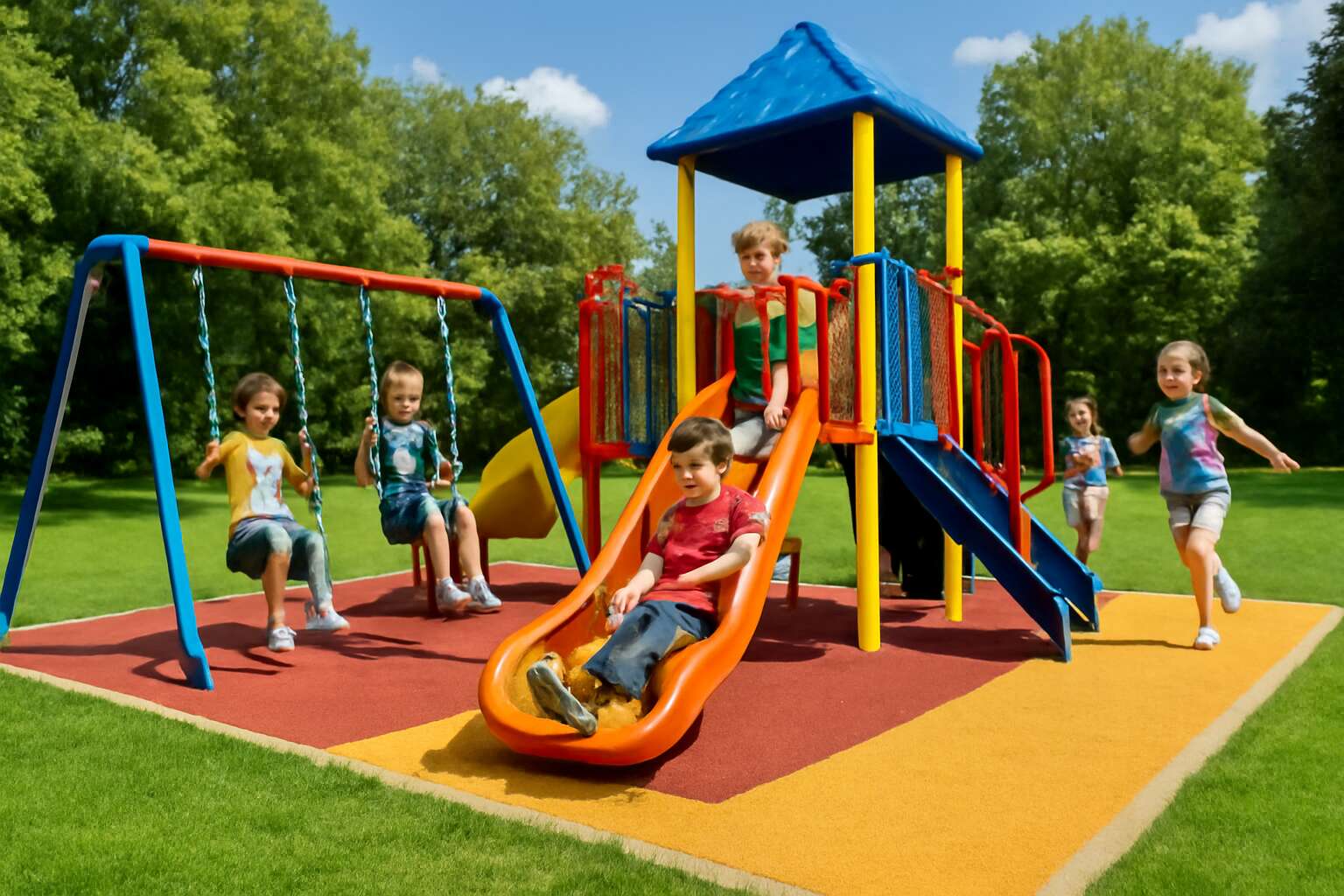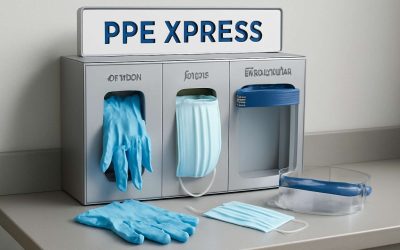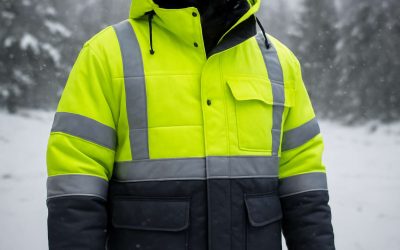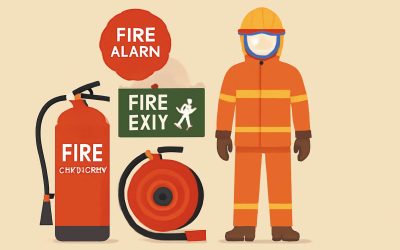Understanding Play Equipment Safety Zones
Definition and Importance – Explains what a safety zone is and why it is crucial for playground safety
Imagine a playground without a designated play equipment safety zone—chaos and chaos alone! A play equipment safety zone is essentially the buffer space surrounding playground equipment, designed to cushion the inevitable tumble or two. It’s the unsung hero of playground safety, providing a vital barrier that keeps children from wandering into harm’s way or colliding with other play structures. Without this zone, what should be a fun-filled adventure risks turning into a potential disaster.
In South Africa, where playground safety standards are becoming increasingly rigorous, understanding the significance of a play equipment safety zone is crucial. This dedicated space isn’t just about ticking boxes; it’s about creating a safe haven where children can explore, jump, and giggle without fear of injury. The importance of maintaining clear, well-measured safety zones cannot be overstated, especially when considering the unpredictable nature of kids’ play. After all, a safety zone isn’t just a line on the ground—it’s a lifeline that ensures play remains joyful and injury-free.
Legal and Safety Standards – Overview of regulations and standards governing safety zones in playgrounds
In the realm of playground safety, understanding the legal and safety standards governing play equipment safety zones is essential. South Africa’s regulations are crafted to balance the joy of play with the imperative of injury prevention. These standards often draw from international benchmarks but are tailored to local contexts, considering factors like climate, terrain, and community needs. The core principle remains unwavering: a well-defined safety zone is non-negotiable for a secure play environment.
Regulatory bodies emphasize that every piece of play equipment should be accompanied by a clearly delineated safety zone—an area free of obstructions and hazards. In some cases, these standards specify minimum dimensions, often based on the height and type of equipment. For instance, a slide might require a safety zone extending at least twice its height to effectively absorb impacts. To ensure compliance, many playground designers follow guidelines that include:
- Minimum safety zone measurements according to equipment size
- Use of impact-absorbing surfacing within the safety zone
- Regular inspection and maintenance protocols to uphold safety standards
Adhering to these standards isn’t merely about adhering to rules; it’s about creating a landscape of trust where children’s laughter is backed by rigorous safety measures. South African regulations serve as a vital safeguard, transforming playgrounds into havens of joyful exploration without compromising safety! The play equipment safety zone, therefore, becomes more than a boundary—it’s a testament to a community’s commitment to nurturing safe, vibrant spaces for its youngest adventurers.
Types of Play Equipment Requiring Safety Zones – Identifies common playground structures that need designated safety areas
Every playground is a stage for boundless imagination and joyful exploration, but safety must always take center stage. Certain types of play equipment demand dedicated play equipment safety zones to protect children from accidental falls and collisions. These zones act as invisible buffers, cushioning the impact of energetic leaps and daring climbs. From towering swings to twisting slides, every structure requires thoughtful planning to ensure safety is woven into the landscape.
While many structures share this need, some play equipment calls for more expansive safety zones. For example, larger climbing frames and multi-activity units often require increased buffer areas to accommodate active play and prevent injuries. The importance of a well-defined play equipment safety zone cannot be overstated—it’s the difference between an enjoyable adventure and a preventable mishap.
Common playground structures that require a play equipment safety zone include:
- Swings, especially those with high backrests or bucket seats
- Slides, particularly those with high or extended platforms
- Climbing frames and multi-activity towers
- Seesaws and spring riders
In South Africa, these safety zones are not just recommendations but essential standards that underpin a child-safe environment. When carefully implemented, they turn playgrounds into vibrant spaces where children’s laughter can ring out without restraint—safely contained within the boundaries of a thoughtfully designed play area.
Designing an Effective Play Equipment Safety Zone
Determining Appropriate Size and Dimensions – Guidelines for calculating safety zone space based on equipment size and usage
In the realm of playground safety, the play equipment safety zone is the unsung hero — often overlooked but absolutely vital. An effectively designed safety zone isn’t just a matter of good practice; it is the buffer that prevents accidents and cushions the inevitable tumble or two. When determining the appropriate size and dimensions, one must consider not only the height and type of play equipment but also the typical usage patterns. A towering slide, for instance, demands a considerably larger safety zone than a modest swing set, ensuring children have ample space to land safely without encroaching on neighboring structures.
Guidelines for calculating this space are surprisingly straightforward yet crucial for compliance with safety standards. For example, a standard rule of thumb is to allocate a minimum of 1.8 meters (six feet) around swings and slides. For more complex or multi-use equipment, the safety zone should extend even further to accommodate the dynamic movements of excited youngsters. Proper planning ensures the play equipment safety zone is not merely a theoretical concept but a tangible safeguard, fostering a playground environment that champions both fun and safety.
Surface Material Recommendations – Best practices for surfacing within safety zones, including impact-absorbing materials
Creating a sanctuary of safety beneath the laughter and adventure of children’s play is a delicate art—one that hinges on the choice of surface material within the play equipment safety zone. A resilient, impact-absorbing ground is more than mere padding; it’s the silent guardian that absorbs the fall’s fury and cushions the tumble of youthful exuberance. The right surfacing transforms a potential hazard into a haven of confidence, where children can explore freely and joyfully.
When selecting terrain, consider materials that combine durability with safety. High-quality rubber mulch, poured-in-place rubber, or resilient mats are often the champions of impact absorption. These materials dissipate the energy of a fall, reducing injury risk significantly. Additionally, natural options like engineered wood fibre or sand can be viable, provided they are maintained to ensure consistent depth and compaction. Always remember, the surface within the safety zone must meet or exceed national safety standards, ensuring a reliable barrier between thrill and peril.
For a playground that truly champions safety, some recommendations include:
- Using impact-absorbing surfacing that meets safety standards.
- Maintaining the proper depth—generally 30-45 cm—based on the equipment’s height.
- Regularly inspecting and replenishing surfacing materials to prevent compaction or deterioration.
In South Africa, where terrain and weather vary widely, choosing the right surfacing material is a vital step in safeguarding play zones. The play equipment safety zone becomes not just a space of fun but a fortress of protection—an essential element woven into the very fabric of playful pursuits.
Clearance and Obstruction-Free Zones – Ensuring unobstructed access and hazards-free surroundings
Creating an unobstructed play equipment safety zone is essential for fostering a secure environment where children can explore with confidence. The key lies in meticulous design—ensuring that every inch around the play structure remains free of hazards and obstructions. When planning the layout, consider the natural flow of movement, leaving ample space for children to run, jump, and land safely without fear of colliding with equipment or other obstacles.
To maintain a hazard-free surroundings, it’s vital to implement a clear zone that is consistently free of debris, furniture, or any potential tripping hazards. For added safety, consider using physical barriers or boundary markers that delineate the safety zone, guiding both children and supervising adults. Regular inspections and maintenance will keep the area pristine and compliant with safety standards, transforming the play equipment safety zone into a sanctuary of adventure and protection.
- Ensure there are no protruding objects or sharp edges within the safety zone.
- Maintain a minimum clearance of 1.5 meters around all sides of play equipment.
- Keep pathways within the safety zone free of clutter to facilitate unobstructed access.
In South Africa’s diverse terrain, designing a play equipment safety zone that is both expansive and obstruction-free is not just about compliance but about creating a magical space where children’s imaginations can soar safely. Every element, from the positioning of equipment to the surrounding landscape, plays a pivotal role in safeguarding young explorers at play.
Materials and Surface Considerations for Safety Zones
Impact-Absorbing Surfaces – Comparison of rubber, mulch, sand, and other surfacing options
Choosing the right impact-absorbing surface for a play equipment safety zone is more than a matter of compliance; it’s a commitment to fostering joyful, injury-free play. Materials like rubber, mulch, and sand each bring their unique qualities to the safety zone, influencing both safety and aesthetics. Rubber surfacing, often made from recycled tires, offers unparalleled shock absorption and durability, making it a popular choice for high-traffic play areas. Mulch, typically wood or engineered wood fiber, provides a natural look and excellent cushioning, but requires regular maintenance to keep its protective qualities intact. Sand, an age-old favorite, is affordable and easy to install, yet it can shift over time, creating uneven surfaces that compromise safety.
When evaluating these options, consider the play equipment involved. For instance, swings and slides benefit from impact-absorbing surfaces that minimize injuries from falls. Sometimes, a layered approach—combining rubber mats at critical points with mulch or sand elsewhere—can create an optimal play equipment safety zone that balances safety, accessibility, and aesthetics.
Maintenance and Durability – Tips to keep surfacing safe and long-lasting
Ensuring the longevity and safety of a playground’s impact-absorbing surfaces is an exercise in meticulous attention to material integrity and environmental resilience. Over time, even the most robust surfacing options—be it rubber, mulch, or sand—succumb to the relentless forces of weather, wear, and the natural cycle of degradation. Regular inspection is paramount; look for signs of compaction, displacement, or breakdown that could undermine their protective qualities or create tripping hazards. Addressing these issues promptly preserves the integrity of the play equipment safety zone and maintains a safe environment for children to explore freely.
Maintenance practices tailored to each surfacing type can significantly extend their lifespan. For rubber surfaces, this might involve sweeping away debris and ensuring proper drainage to prevent water pooling, which accelerates deterioration. Mulch should be replenished periodically to compensate for compaction and displacement, maintaining a consistent depth that cushions falls effectively. Sand surfaces require raking and redistribution to prevent unevenness—an insidious threat to safety zones, especially around high-traffic areas. An organized, scheduled approach to upkeep ensures surfaces remain resilient and hazard-free, fostering an inviting space where children’s imaginations can flourish without risk.
In the intricate dance of safety and aesthetics, layered surfacing strategies often prove most effective. Combining impact-absorbing materials—such as rubber mats at critical fall zones with natural mulch or sand in less trafficked areas—can optimize durability and safety. To make this work seamlessly, consider implementing a physical barrier or edging that contains the surfacing materials and prevents migration, which is a common source of safety compromise. Remember, a well-maintained play equipment safety zone isn’t just about meeting standards—it’s a testament to a community’s commitment to nurturing safe, joyful play environments that withstand the test of time and elements.
Weather Impact and Drainage – Ensuring safety surfaces perform well in different weather conditions
In the unpredictable theatre of South African weather, a resilient play equipment safety zone is no longer a luxury but an absolute necessity. Torrential rains, scorching sun, and the occasional dust storm conspire to test the mettle of your playground’s surfaces. Ensuring these safety surfaces perform in diverse weather conditions requires more than just a cursory glance—think of it as an ongoing dialogue with the elements.
Proper drainage is the unsung hero of a durable safety zone. Surfaces like rubber mats or sand need efficient channels to whisk away excess water, preventing dangerous pooling or slick patches that could turn children’s joyrides into slips and slides. When choosing materials, consider how they respond to South Africa’s climate extremes—impact-absorbing surfaces should retain their cushioning qualities even after relentless sun or heavy rain.
For added peace of mind, layered surfacing strategies can be employed—combining impact-absorbing rubber at high-fall zones with natural mulch or sand in less trafficked areas. This approach not only bolsters safety but also offers a visual harmony that invites endless play. To keep everything in check, regular inspections and maintenance—raking sand, replenishing mulch, and clearing debris—are essential. After all, a well-maintained play equipment safety zone isn’t just a regulatory checkbox; it’s a sanctuary for safe, unencumbered childhood adventures.
Installation and Maintenance of Safety Zones
Proper Installation Practices – Step-by-step guidelines for correct safety zone setup
Creating a play equipment safety zone isn’t just about marking boundaries; it’s about ensuring every child’s safety is prioritized during play. Proper installation of this zone is critical to prevent accidents and injuries. Start by measuring the play equipment’s dimensions carefully, then add a clear buffer space around it. This safety zone should be free of obstacles, providing ample room for children to move freely without risk of collision.
In South Africa, adherence to local safety standards is essential. When installing the safety zone, follow a step-by-step process: first, clear the area of debris, then lay down impact-absorbing surfacing material such as rubber or mulch. This ensures the safety surface performs well in all weather conditions. Regular inspections are vital—look out for signs of wear and tear, and maintain the surface to keep it durable and safe for extended use.
Regular Inspection and Safety Checks – Routine assessments to identify hazards and wear
In the bustling world of childhood adventures, a play equipment safety zone acts as the enchanted boundary where imagination and safety entwine. Yet, even the most magical playground can turn perilous without vigilant maintenance and routine inspections. Regular safety checks are the guardian angels of any play area, ensuring that hazards do not creep into the sanctuary of childhood joy. It’s essential to adopt a systematic approach to maintenance, catching wear and tear before they become threats.
For instance, a simple yet effective method is to implement an ordered safety inspection checklist. This includes examining the impact-absorbing surfacing for signs of compaction or displacement, ensuring that no debris or obstructions mar the safety zone. Keeping the play equipment safety zone pristine is a dance of ongoing care—each inspection a step towards safeguarding young explorers. When issues are detected, swift action to repair or replace damaged surfacing or equipment preserves the integrity of the entire play environment.
- Check for loose or corroded bolts and parts.
- Ensure surfacing materials are evenly distributed and free from hazards.
- Remove any debris, litter, or obstacles that could hinder free movement.
By prioritizing these routine assessments, playgrounds in South Africa remain a haven where kids can revel in their adventures without the shadow of injury lurking nearby. In this enchanted realm, safety and joy walk hand in hand, protected by diligent inspection and tender upkeep of the play equipment safety zone. Only through such care can the magic of play truly flourish, casting a spell of safety that endures in every child’s heart.
Repairs and Upgrades – When and how to update safety zones to maintain compliance
Maintaining a play equipment safety zone isn’t just about initial installation; it’s a continual process of renewal and vigilance. Over time, even the most robust safety features can degrade, making repairs and upgrades an essential part of safeguarding young explorers. When should you consider updating your safety zone? If surfacing materials show signs of excessive wear, or if the equipment no longer complies with evolving safety standards, it’s time to act. Regular assessments help identify these issues early, preventing potential hazards from becoming reality.
Upgrading safety zones involves a strategic approach—prioritizing repairs that restore the integrity of impact-absorbing surfaces or replacing corroded bolts and worn-out surfacing materials. For example, an ordered list of steps can streamline this process:
- Assess the current condition of surfacing and equipment.
- Determine if repairs or upgrades are necessary to meet safety standards.
- Source compliant impact-absorbing materials suited for South African weather conditions.
- Implement proper installation practices to ensure durability and safety.
- Schedule future inspections to monitor ongoing safety compliance.
When updating a play equipment safety zone, it’s vital to stay aligned with legal and safety standards, ensuring the playground remains a secure haven. Whether it’s adding new impact-absorbing surfaces like rubber mulch or replacing aging equipment, each upgrade reinforces the sanctuary where children’s laughter thrives. Continuous maintenance and thoughtful upgrades are the secret to preserving a resilient safety zone—one that evolves with safety regulations and offers peace of mind for everyone involved.
Enhancing Play Area Safety with Strategic Zoning
Designing Zone Layouts for Multiple Equipment – Creating logical and safe zones for various play structures
Creating a harmonious symphony of play requires more than just vibrant structures; it demands a meticulously crafted play equipment safety zone that whispers safety and sings of fun. When designing zone layouts for multiple equipment, visual harmony and practical safety intertwine—transforming chaos into clarity. By establishing logical boundaries, each piece of play equipment finds its own sanctuary, free from the shadows of collision and chaos.
Imagine a playground where climbing frames, slides, and swings each breathe in their designated space, their boundaries softly yet securely defined. An effective approach involves considering the unique dimensions and usage of each structure, ensuring the safety zone is generous enough to accommodate the lively energy of children.
- Implementing clear, unobstructed pathways between zones
- Ensuring that each safety zone is free of hazards and obstructions
- Using impact-absorbing surfaces tailored to each play area’s needs
This strategic zoning cultivates an environment where safety and enjoyment dance in perfect tandem, safeguarding young adventurers while igniting their boundless curiosity.
Accessibility and Inclusivity – Ensuring safety zones accommodate children with different abilities
Creating an inclusive play environment isn’t merely about slapping down equipment and hoping for the best; it’s about thoughtful, strategic zoning that champions accessibility and safety for every child. A well-designed play equipment safety zone ensures children of all abilities can enjoy the thrill of play without risking injury or exclusion. When properly planned, these zones become welcoming spaces where diversity in mobility—whether wheelchair users or children with sensory sensitivities—is seamlessly accommodated.
To enhance safety and inclusivity, consider implementing features such as tactile guides, textured surfaces, and gentle slopes within the play equipment safety zone. These elements help children with visual or physical impairments navigate comfortably and confidently. Moreover, clear pathways and unobstructed access points should be prioritized, ensuring that every child can move freely from one play zone to another without barriers. An effective layout often employs
- impact-absorbing surfacing
- wide, accessible entrances
- low-threshold ramps
to create a truly barrier-free environment.
Ultimately, a thoughtfully designed safety zone isn’t just about meeting standards; it’s about fostering an atmosphere of genuine inclusivity where the joy of play knows no bounds. When accessibility and safety coalesce in strategic zoning, the playground transforms into a vibrant hub of fun, learning, and unity for children of all abilities.
Signage and Boundary Indicators – Using visual cues to delineate safety zones clearly
Strategic zoning in playgrounds isn’t just about delineating space; it’s about using visual cues to communicate safety boundaries clearly. Well-placed signage and boundary indicators serve as silent guardians, guiding children and parents alike to respect designated play equipment safety zones. Bright, contrasting colors on barriers or painted lines on the ground can instantly alert everyone to the limits of safe play areas, reducing accidental intrusions into hazardous zones.
Effective signage should be simple and universally understandable, incorporating symbols or pictograms that transcend language barriers. Incorporating tactile boundary markers or textured surfaces can further enhance visibility for children with sensory impairments, making the play environment more inclusive. For areas with multiple play structures, consider numbered zones or color-coded boundaries to assist supervision and ensure each child remains within their safe zone.
- Implement clear, high-visibility boundary markers around each play equipment safety zone.
- Use visual cues like contrasting colors and tactile indicators to enhance awareness.
- Ensure signage is legible and positioned at eye level for both children and supervising adults.
When boundary indicators are thoughtfully integrated into the playground design, safety becomes intuitive. Children learn to recognize and respect their play zones naturally, fostering independence and reducing risks. For playground operators, these visual cues act as constant, non-intrusive reminders that safety is a shared responsibility—making the entire play area a safer, more welcoming space for all.
Common Mistakes to Avoid in Play Equipment Safety Zones
Insufficient Space and Overcrowding – Risks associated with inadequate safety zones
In the realm of playground design, neglecting the intricacies of a play equipment safety zone can transform a joyous haven into a perilous trap. Overcrowding and insufficient space are silent architects of disaster, often underestimated yet tragically common mistakes. When multiple play structures encroach upon a limited safety zone, the risk of collisions and falls escalates exponentially. Children, eager explorers by nature, may inadvertently venture into hazardous zones if boundaries are ambiguous or poorly defined.
A critical oversight involves ignoring the recommended safety zone dimensions, which are meticulously calculated to accommodate the dynamic movements of children. Without adequate clearance, the chance of accidents surges—an invisible threat lurking behind seemingly benign playgrounds. Emphasizing the importance of creating clearly marked, unobstructed boundaries within the play equipment safety zone ensures that children can enjoy their play without undue risk. Properly designed safety zones, free from obstructions and overcrowding, form the backbone of a secure play environment that fosters both fun and safety.
Poor Surface Maintenance – Impacts of neglected surfacing materials
Neglecting the maintenance of surface materials within the play equipment safety zone can turn a delightful playground into a potential hazard. Over time, neglect leads to worn, uneven, or compacted surfaces that fail to absorb impact effectively, increasing the risk of injury from falls. Children’s playful energy often results in rough landings, and a compromised surface can amplify the severity of injuries.
Common mistakes include neglecting regular inspections of surfacing materials like rubber, mulch, or sand. When these surfaces become packed or contaminated with debris, their ability to cushion falls diminishes dramatically. To ensure safety and durability, routine maintenance such as raking, topping up, or replacing worn-out surfacing is essential. Remember, a well-maintained play equipment safety zone is the first line of defense against playground injuries and is vital for creating a secure, welcoming environment for children to explore freely and safely.
Ignoring Local Regulations – Consequences of non-compliance and best practices for adherence
In the delicate dance of safeguarding our children’s laughter and exploration, one misstep can turn a joyful playground into a perilous stage. Ignoring local regulations when designing or maintaining a play equipment safety zone is a mistake that echoes with consequences—potentially catastrophic injuries that could have been prevented. Regulations aren’t mere bureaucratic hurdles; they are the silent guardian angels whispering the rules of safety, ensuring that each space is a sanctuary rather than a trap.
Failure to adhere to these standards often stems from oversight or complacency, yet the implications are profound. Non-compliance can lead to legal repercussions, hefty fines, or worse—an accident that scars a child’s life forever. Best practices for compliance involve meticulous knowledge of national and local legislation, regular consultation with safety standards, and a proactive approach to updates in safety protocols. These measures, though seemingly meticulous, forge an unbreakable shield around the play area, transforming it into a haven of secure adventure.
Remember, a well-regulated play equipment safety zone isn’t just about ticking boxes; it’s about crafting an environment where children’s imagination can flourish unhindered by lurking hazards. Ensuring adherence to local regulations is the cornerstone of playground safety—an unyielding promise that every giggle and leap occurs within the bounds of safety and care.




0 Comments